You are using an out of date browser. It may not display this or other websites correctly.
You should upgrade or use an alternative browser.
You should upgrade or use an alternative browser.
MundoHiFiOz
100+ Head-Fier
Pros: Beautiful Design
Mqa
Low battery consumption
Black background, no hiss
Hiby music certification
Mic support
Mqa
Low battery consumption
Black background, no hiss
Hiby music certification
Mic support
Cons: Large volume jumps
No hardware volume
No hardware volume
Disclaimer: TempoTec graciously sent me the Sonata E44.
Gear used:
ATH AD-1000X, final b3, hifi boy osv3
Gear used:
ATH AD-1000X, final b3, hifi boy osv3
About Tempotec:
TempoTec is a company based in China conformed by a group of experts in the pursuit of "the best sound quality". You can find more here: https://www.tempotec.net/pages/about-tempotec
Specifications:
OUTPUT: 2VRMS
SNR: 128dB
THD+N: -112dB
OUTPUTPOWER: 70MW/32ohm
SUPPORT: MQA 8X
SUPPORT: TIDAL
SUPPORT: DSD128
SUPPORT: PCM 32bit/384kHz
MQA Decoding
HiBy music app
HiRes certified
70mw high power,low battery consumption
Direct Stream Digital DSD128
Aluminium-alloy body
Type-c port
3.5mm earphone port
Packaging and accessories:
TempoTec is a company based in China conformed by a group of experts in the pursuit of "the best sound quality". You can find more here: https://www.tempotec.net/pages/about-tempotec
Specifications:
OUTPUT: 2VRMS
SNR: 128dB
THD+N: -112dB
OUTPUTPOWER: 70MW/32ohm
SUPPORT: MQA 8X
SUPPORT: TIDAL
SUPPORT: DSD128
SUPPORT: PCM 32bit/384kHz
MQA Decoding
HiBy music app
HiRes certified
70mw high power,low battery consumption
Direct Stream Digital DSD128
Aluminium-alloy body
Type-c port
3.5mm earphone port
Packaging and accessories:
Apart from being the newest usb dac/amp that TempoTec has launched, the MHD ($89) is also the first MQA compatible device that this famous brand launches to the market. This time the MHD comes in a basic cardboard box with some accessories inside like an USB type A to type c adapter, a hi-res sticker and small cleaning towels but sometimes through the official stores you can also get for free an USB type c to lightning adapter ($20) and a MQA hiby music subscription.
Like most of the customers that bought the MHD I also received the apple lighting adapter. This cable is soft and it allowed me to use my iphone with the MHD and the rest of dongle dacs that i have like the E44 from tempotec or the iFi go blue. No matter what kind of ios device you use, the adapter will be compatible with ios versions even lower than 14.6. One thing I liked from this accessory is the length it has, with just 9.3cm and a very flexible cable it can be adjusted in different ways to avoid being very bulky.
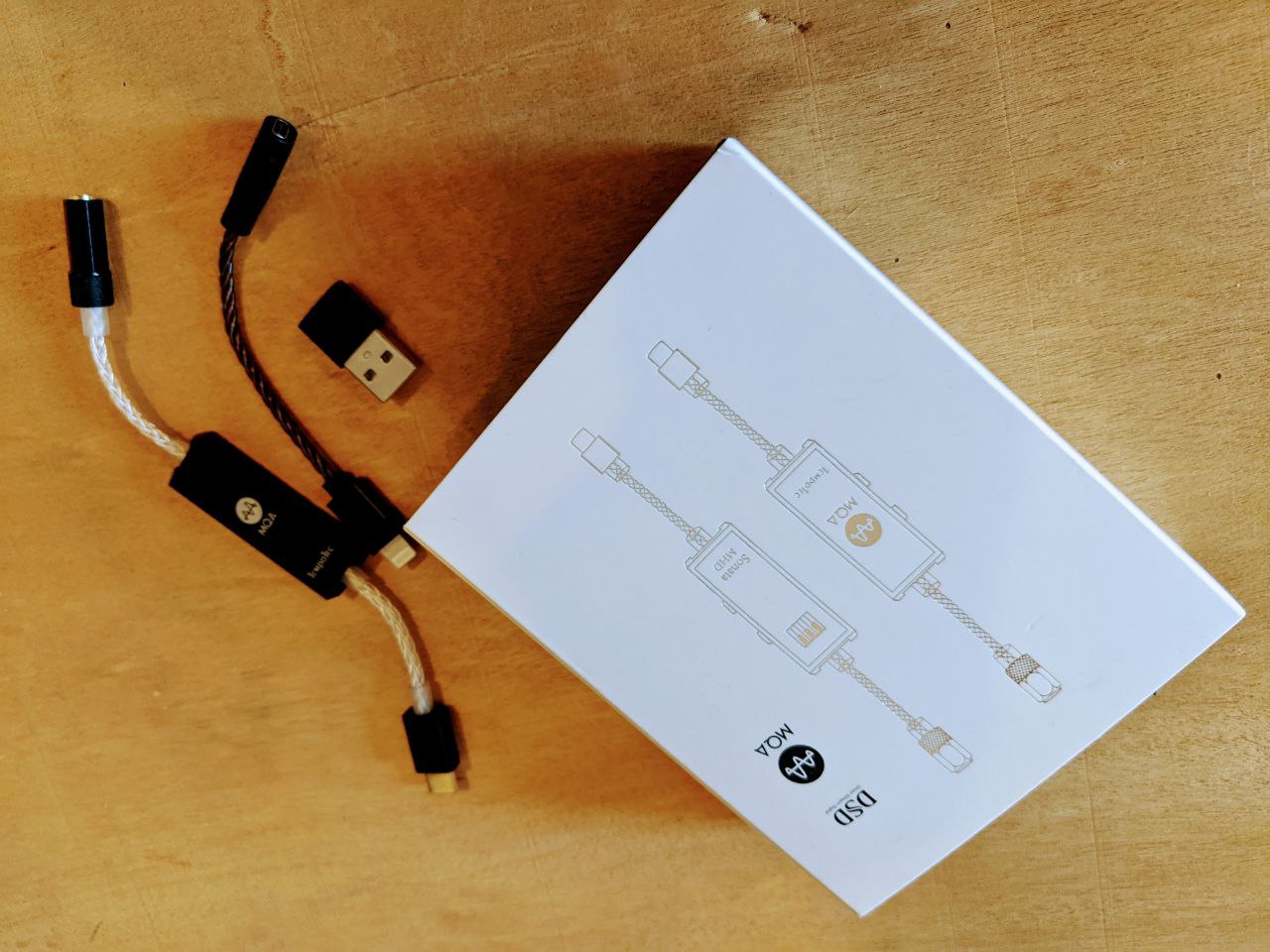
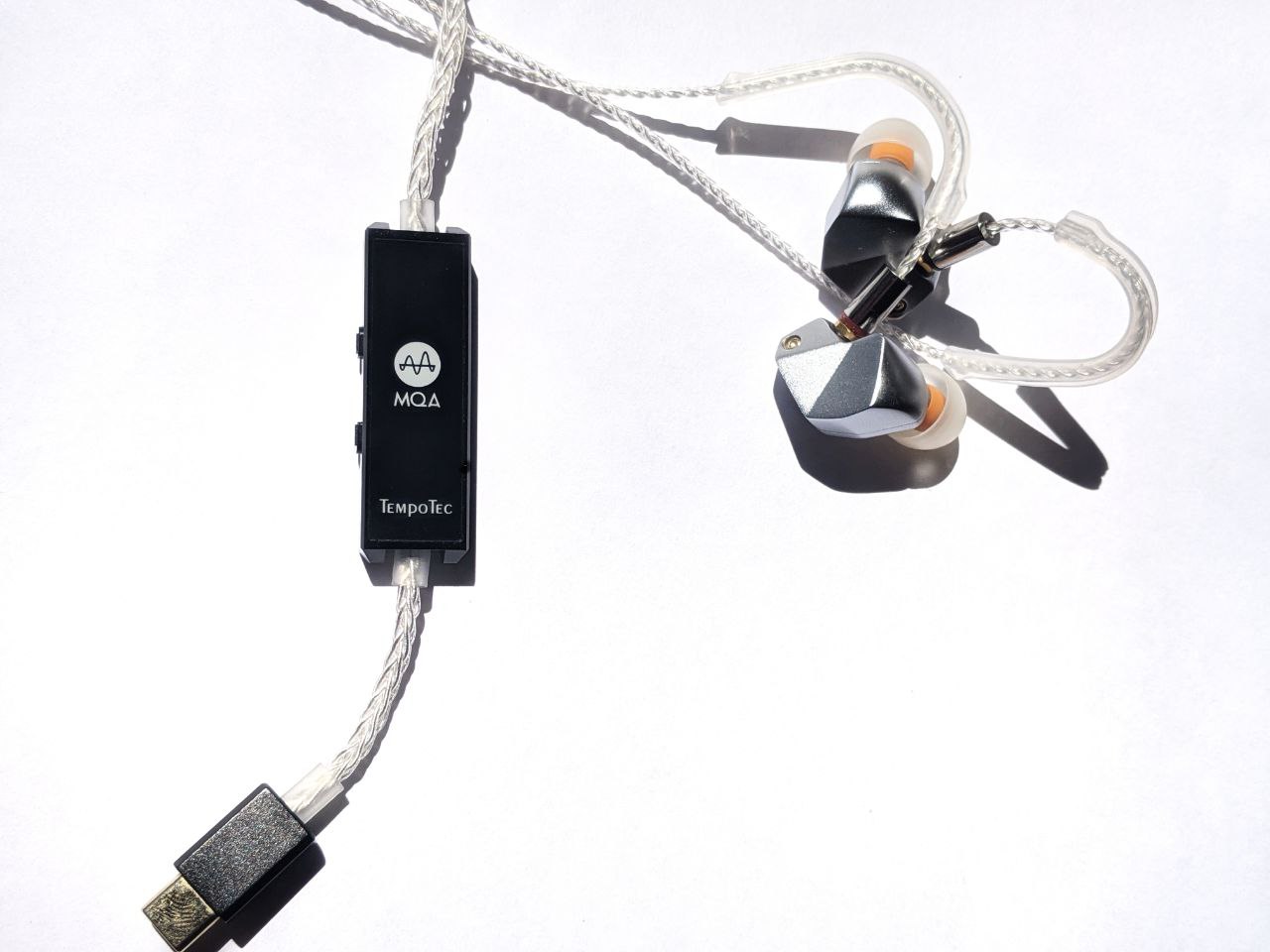
Design:
Like most of the customers that bought the MHD I also received the apple lighting adapter. This cable is soft and it allowed me to use my iphone with the MHD and the rest of dongle dacs that i have like the E44 from tempotec or the iFi go blue. No matter what kind of ios device you use, the adapter will be compatible with ios versions even lower than 14.6. One thing I liked from this accessory is the length it has, with just 9.3cm and a very flexible cable it can be adjusted in different ways to avoid being very bulky.
Design:
This new product also introduces a new feature in the design, if I'm not wrong, it's the first usb dac amp from the brand that includes a led light in its figure. Unlike the previous products of this type that tempotec launched that looked very elegant and sober, the MHD has a trendy and fresh design that looks even better once the led lights up. This led can change up to 4 different colours according to the file format that you play:
Blue: PCM 32-48kHz
Green: PCM 88.2-192kHz/ DSD64
Light green: PCM 352.8-384kHz/DSD128
Red: connected
Blue: PCM 32-48kHz
Green: PCM 88.2-192kHz/ DSD64
Light green: PCM 352.8-384kHz/DSD128
Red: connected
The build quality of the MHD is good, it has a black aluminium chassis with the front and back faces showing the MQA and tempotec logos. The non detachable cable has a soft texture and is covered on both ends by a plastic protection. Based on my experience, I expect the cable to remain in good conditions for months without breaking.
On the laterals the MHD has 2 buttons that control the volume of your phone or computer. Unlike previous tempotec products, this is not a hardware volume control so the jumps are a bit higher especially if you don't use an app like audirvana or hiby music that allows you to control the volume with precision.
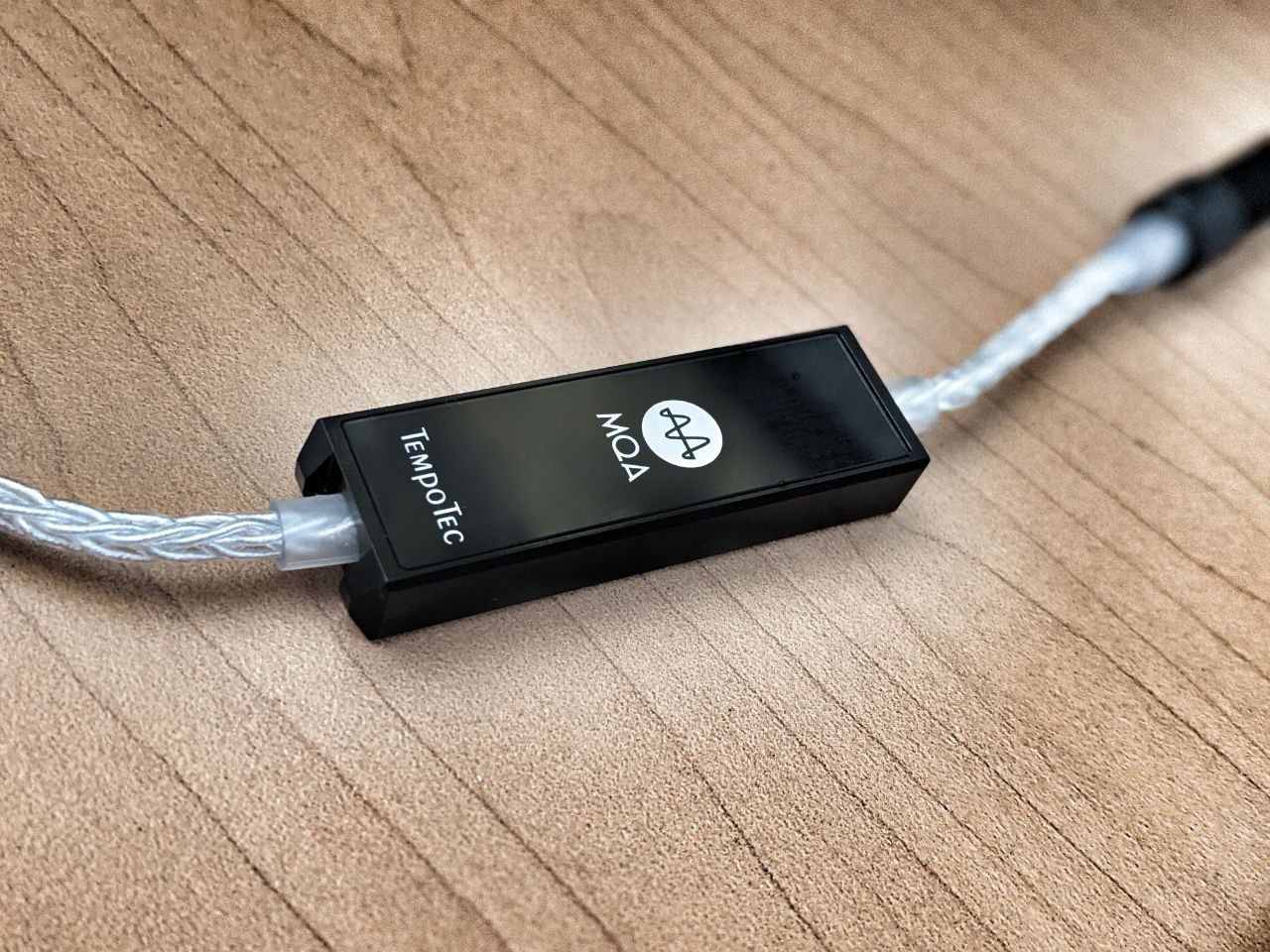
Daily use:
MQA Comes To The Family


On the laterals the MHD has 2 buttons that control the volume of your phone or computer. Unlike previous tempotec products, this is not a hardware volume control so the jumps are a bit higher especially if you don't use an app like audirvana or hiby music that allows you to control the volume with precision.
Daily use:
It's really easy to use this kind of device, just plug it to your phone or PC and that's it!
One of the main features of this device is its capability to support MQA files. I used the hiby music app on my phone and audirvana on PC to test this characteristic and it worked as expected. One thing you need to know is that if you want to play Tidal MQA tracks with the MHD first you'll have to download and buy the MQA hiby music subscription. This app is one of the best in the market for using usb dac/amps and it's fully compatible with the MHD thanks to the authentication that allows exclusive USB audio access.

One of the main features of this device is its capability to support MQA files. I used the hiby music app on my phone and audirvana on PC to test this characteristic and it worked as expected. One thing you need to know is that if you want to play Tidal MQA tracks with the MHD first you'll have to download and buy the MQA hiby music subscription. This app is one of the best in the market for using usb dac/amps and it's fully compatible with the MHD thanks to the authentication that allows exclusive USB audio access.
TempoTec also claims that the MHD supponts calls and that's true, it will allow you to use any kind of headphones with a microphone and attend your online meetings or phone calls.


In terms of energy consumption the MHD is a very efficient device. Using my Google pixel phone, the MHD drained 10% of the battery in 30 minutes, while other similar products can drain about 30% in that period of time. Last, this device always keeps cold even after hours of use.
Now let's talk about the pairings: with sensitive IEMs I wasn't able to hear electronic noise or hiss and with high impedance headphones like hd600 this device produces a competent sound but it fails to achieve what other dongle dacs like the E44 or iFi go blue can do with these kind of headphones.
To be honest, I wasn't expecting it to drive high impedance headphones with ease because these kinds of devices are meant to be used with earphones and low impedance headphones like the MSR7b or X2HR.
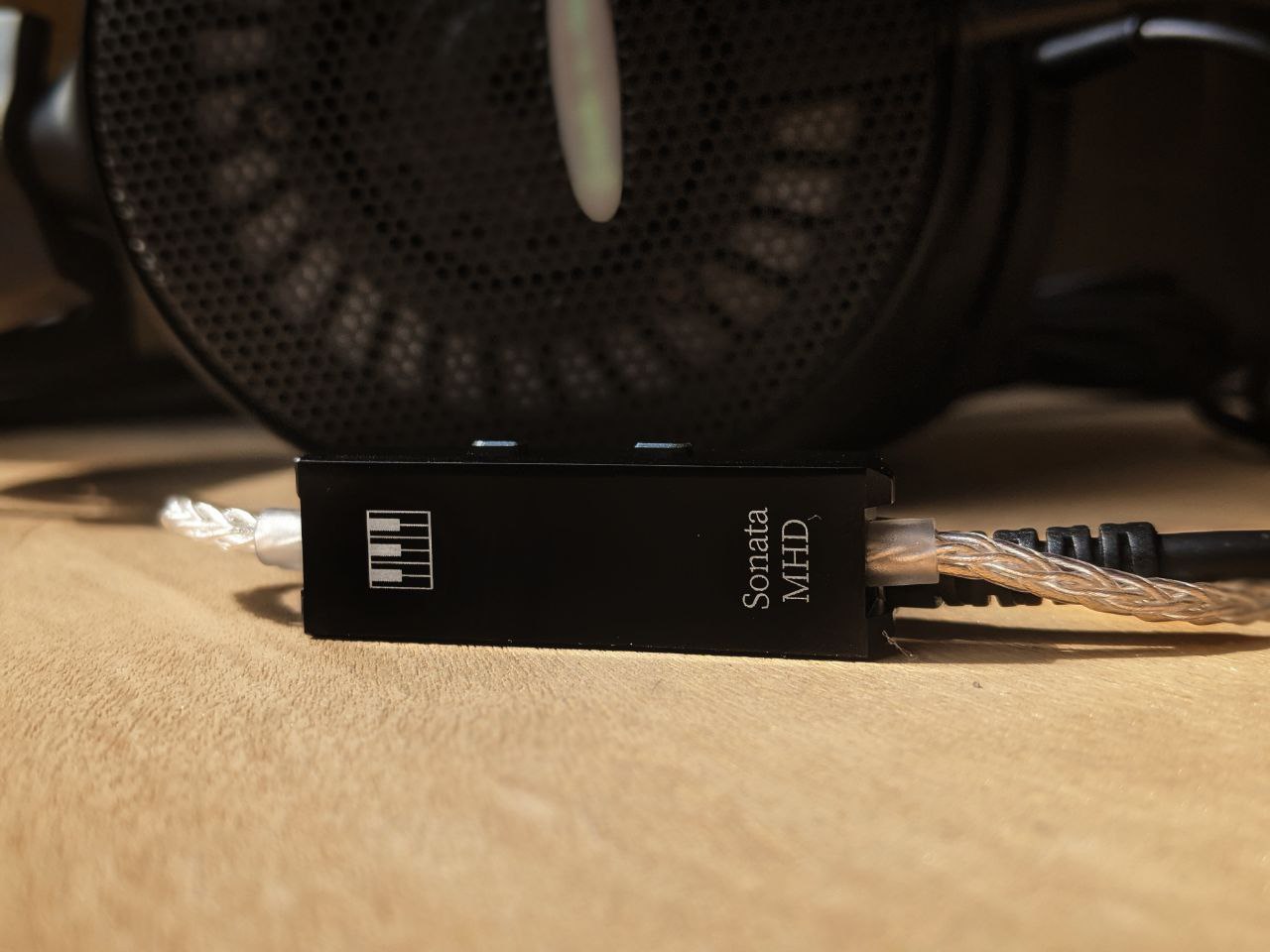
Sound
Now let's talk about the pairings: with sensitive IEMs I wasn't able to hear electronic noise or hiss and with high impedance headphones like hd600 this device produces a competent sound but it fails to achieve what other dongle dacs like the E44 or iFi go blue can do with these kind of headphones.
To be honest, I wasn't expecting it to drive high impedance headphones with ease because these kinds of devices are meant to be used with earphones and low impedance headphones like the MSR7b or X2HR.
Sound
I was very surprised with the sound of the E44, it delivered a wonderful coherence, great amplification and a performance over its price range. In this case the MHD sounds way different from the previous launch, the sound can be described as being dynamic.
In the bass region the device accentuates the mid-bass delivering a punchy and satisfying low end, the bass hits hard and the kick drums have more presence than usual. The elevation in the mid-bass is done in a natural way preserving speed, details and not feeling overly saturated with the earphones I tested. Sub-bass has a natural presence and in general it delivers a fuller bass response than most cell phones or computers.
I had mixed feelings with the performance of the midrange, with iems like the final B3 i found forward vocals that presented sibilance while with the Hifi boy osv3 or AME J1UX iems, the midrange was very transparent and resolving. Overall I find that the MHD has a better performance with warm sounding earphones, especially those who have a balanced or neutral sound because this device tries to push forward the details and sometimes you can feel the edges of the instruments or vocals.
Treble is the best part of the sound thanks to its neutrality and good separation. There's no congestion even with difficult tracks and the level of detail is good. With headphones like the ATH AD1000X the results are great, there is no harshness and the characteristic breeze that these headphones produce is there.
In general the sound has good speed, clean transitions and a competent technical performance. One thing to notice is that even though it has an intimate soundstage, the imaging is really accurate making easy to identify sounds.
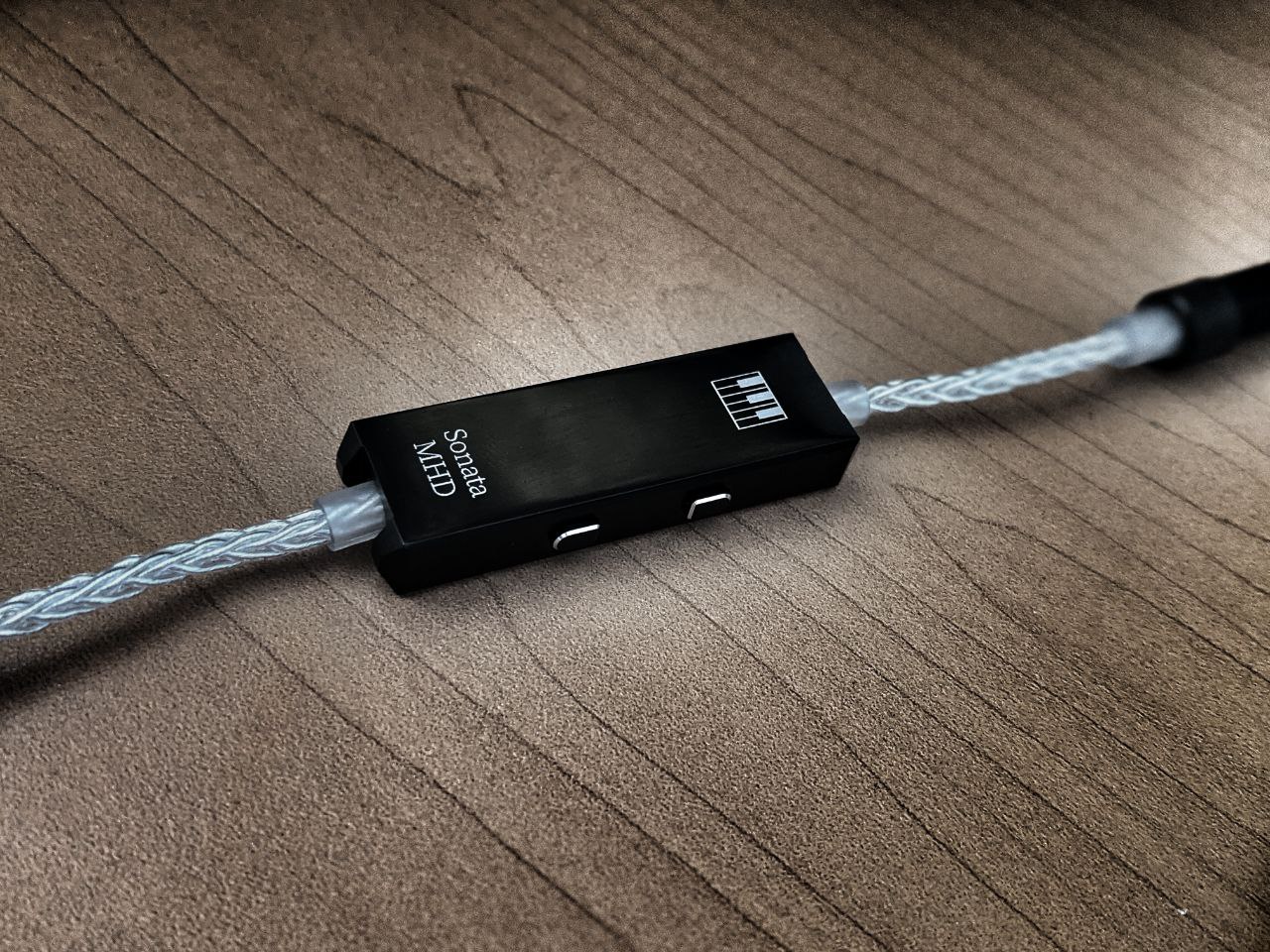
Comparisons:
In the bass region the device accentuates the mid-bass delivering a punchy and satisfying low end, the bass hits hard and the kick drums have more presence than usual. The elevation in the mid-bass is done in a natural way preserving speed, details and not feeling overly saturated with the earphones I tested. Sub-bass has a natural presence and in general it delivers a fuller bass response than most cell phones or computers.
I had mixed feelings with the performance of the midrange, with iems like the final B3 i found forward vocals that presented sibilance while with the Hifi boy osv3 or AME J1UX iems, the midrange was very transparent and resolving. Overall I find that the MHD has a better performance with warm sounding earphones, especially those who have a balanced or neutral sound because this device tries to push forward the details and sometimes you can feel the edges of the instruments or vocals.
Treble is the best part of the sound thanks to its neutrality and good separation. There's no congestion even with difficult tracks and the level of detail is good. With headphones like the ATH AD1000X the results are great, there is no harshness and the characteristic breeze that these headphones produce is there.
In general the sound has good speed, clean transitions and a competent technical performance. One thing to notice is that even though it has an intimate soundstage, the imaging is really accurate making easy to identify sounds.
Comparisons:
Tempotec e44: The e44 is one or two steps above in sound quality and level of amplification, it presents more coherence, a better extended bass and a natural smooth midrange. One of the biggest differences is found in the transitions and speed of the sound, the MHD sounds more energetic and engaging, the small lift in mid-bass gives the sensation of a punchier low end while the e44 sounds more relaxed and overall the sound is weightier.


Midrange is also very different, the e44 presented more texture no matter which headphones I used, vocals had a better timbre, more body and never sounded sharp or aggressive unless the recording required it.
In terms of soundstage, both have similar width and depth but the e44´s ability to define and recreate the stage has no comparison. With full size headphones this was notorious and the difference in power output also had a big influence especially in the bass performance and density of sounds.
One big advantage of the MHD is that it has the MQA tech inside so this can be a decisive point for some buyers looking to use tidal. Finally i think that the e44 and MHD are products for 2 different types of customers, the first one is for a more experienced audiophile and the latter for a person looking for a more versatile device.

Conclusions
In terms of soundstage, both have similar width and depth but the e44´s ability to define and recreate the stage has no comparison. With full size headphones this was notorious and the difference in power output also had a big influence especially in the bass performance and density of sounds.
One big advantage of the MHD is that it has the MQA tech inside so this can be a decisive point for some buyers looking to use tidal. Finally i think that the e44 and MHD are products for 2 different types of customers, the first one is for a more experienced audiophile and the latter for a person looking for a more versatile device.
Conclusions
Tempotec keeps improving and launching attractive products to a very competitive market. I liked the new features they added to the MHD and I hope they launch a newer version of their portable dac amp, the idsd plus or even an improved version of the E44.
Finally, MQA and the possibility to make phone calls are the 2 main features of the MHD, it has a solid build, attractive design, enough power output for most of the earphones and it is easy to use. In terms of sound this is a competent dac/amp when compared to products like hilidac beam 2se or sonata hdpro but it fails to reach the level of the E44.
Finally, MQA and the possibility to make phone calls are the 2 main features of the MHD, it has a solid build, attractive design, enough power output for most of the earphones and it is easy to use. In terms of sound this is a competent dac/amp when compared to products like hilidac beam 2se or sonata hdpro but it fails to reach the level of the E44.
cqtek
1000+ Head-Fier
Pros: MQA 8X with integrated volume control.
- Possibility to change the maximum voltage (1V, 2V) via firmwares.
- Technical specifications and remarkable measurements.
- Remarkable sound quality.
- Possibility to change the maximum voltage (1V, 2V) via firmwares.
- Technical specifications and remarkable measurements.
- Remarkable sound quality.
Cons: It does not come with a case to store and protect it.
- The transparent plastic protectors are not suitable for this model, they are from the E series.
- The transparent plastic protectors are not suitable for this model, they are from the E series.
Introduction
Tempotec continues to squeeze its Sonata series and when it seems that there is nothing left to design, within this series, I forget that there is an acronym that I have not taken into account. It's "MQA", something that Tidal users will know very well and that this new MHD supports up to 8X, always under the HiBy Music application. Of course, it also supports DSD and DXD. Although it has very similar cables to the E44, its connection is 3.5mm SE and its body is smaller and slimmer. On the main face is the MQA logo, under which there is a multicoloured LED, indicating the status or type of file being played. On this occasion, the volume buttons are 2 and on the side. Tempotec has used the ESS Sabre ES9281 integrated DAC/AMP, so well known and used in multiple dongles. Undoubtedly, the big advantage of this new product, apart from the MQA 8X decoding, is the integrated volume control, which sets it apart from some of its competitors. We will see the rest of the features below.


Disclaimer
Tempotec, offered me this model, in exchange for writing an honest review. I want to make it clear that all my opinions written in this review have not been conditioned by this fact, nor will I ever write anything that I do not really think or feel here. I will only write about my personal opinion in relation to the revised product.

Specifications

Packaging
The MHD comes in a box very similar to the E44 and E35. It is a white box with dimensions 127x100x35mm. On the front side you can see a couple of pictures of the edges of the MHD, showing each side of the device. On the back of the box is only the brand, the model, the website, the e-mail address, several QR and an EAN13. After removing the outer cardboard, a complete black box is visible again. It opens like a chest and inside you can see the MHD, the USB Type-C to classic USB adapter and a sticky Hi-Res logo, inside a thick foam moulding. Underneath, there's little else. The complete contents are:
Everything is the same as in the previous models. And I insist on "the same," because the plastic protectors are not suitable for this new MHD, but for the previous models E35 and E44. A flaw in the accessories which, on the other hand, is not necessary on the rear face, as it is completely made of aluminium. It would make sense to have protection on the main side of the device, just to avoid scratches.
Finally, the set comes with a USB-C female to lightning male adapter as a free gift.


Construction and Design
Tempotec continues with the centre-pin design, silver-plated monocrystalline copper 8-strand cable for each end, USB Type-C connector on one side and 3.5mm SE connector on the other end. Each connector is gold-plated and identical to those on the E35. The USB male connector sleeve is the same colour as the body and is oval in shape. The headphone output connector sleeve starts out as a cylinder that turns into a rather bulky hexagon. It is also the same colour as the body. The centre pickup is smaller and narrower and still has ridges on its corners and a groove in the area where it meets the cables. It is still a black aluminium case, but, this time, the back is made entirely of aluminium. The buttons are two small ones, located on one side. The top face is glazed and has the MQA logo in its centre and the Tempotec branding at the bottom. Underneath the logo is a multicoloured LED that lights up depending on the status. The rear face has the brand logo at the top, close to the earphone output, and the model name at the bottom. The partial measurements are as follows:
The weight of the pickup is light and the connectors are slightly heavier.
As you can see, there is a slight change in shape from the E-series, it is smaller and thinner, mostly covered in aluminium and with 2 side buttons for volume control. Everything else is very similar to its cousins.


Connectivity
The Sonata MHD has a USB Type-C connection, which limits it to Android, PC and DAPS compatible systems. Connected to a Windows PC it is Plug&Play, being compatible with version 10 without the need for additional drivers. It has no ASIO driver and will not be compatible with older versions of Windows.
Connected to an Android device, it is advisable to activate the "OTG" and "USB debugging mode" options. To enjoy MQA decoding it is convenient to use the HiBy Music APP.

Operativity
The E35 has 30 volume steps. But when connected to Windows, pressing each button changes the system volume by two points, giving 50 volume steps.
Apart from the advice to use the HiBy Music APP, the operation is not too difficult, apart from the fact that it seems to remember the volume position.
The Sonata MHD is able to operate in two modes, depending on the earphone connected: if it has a microphone, it automatically sets itself to call mode. If it doesn't, it auto-configures itself to HiFi mode.
The colour of the light indicates the status of the MHD, as shown below:
Finally, it is worth noting that the MHD has a Fade-In effect, around 2 seconds, when it starts playing. There may be people who like this effect, personally, I hate it.


Measures
Tempotec certainly doesn't disappoint. If it says it delivers 70mW at 32 Ω, it does. And my first feeling was astonishment when I saw that the maximum no-load voltage barely exceeded 1 V. But how? I thought. If 2V is specified, how come it only gives 1V? My first thought was that it might have some kind of high gain mode, depending on the load connected. But it doesn't. The second thing I thought of was firmware that would provide that high gain, and so it does. I contacted Tempotec and told them about my measurements. They quickly replied and told me what I was thinking. There are two firmwares, one that provides a maximum output of 1V and one that gives 2V. The update is very simple and quick. The reason, according to the brand itself, is that with 1V they are able to offer a more precise volume control, as the jumps are not so big. Something that, on the other hand, I have come to comment on their E-series cousins.
As can be seen from the measurements at 100 Ω, the output impedance is very low, less than 1, as the voltage is the same as at no load.
Below you can see the measurements with the two firmwares.
No load firmware 1V
It can be seen that the output voltage is clean and slightly above 1V RMS.
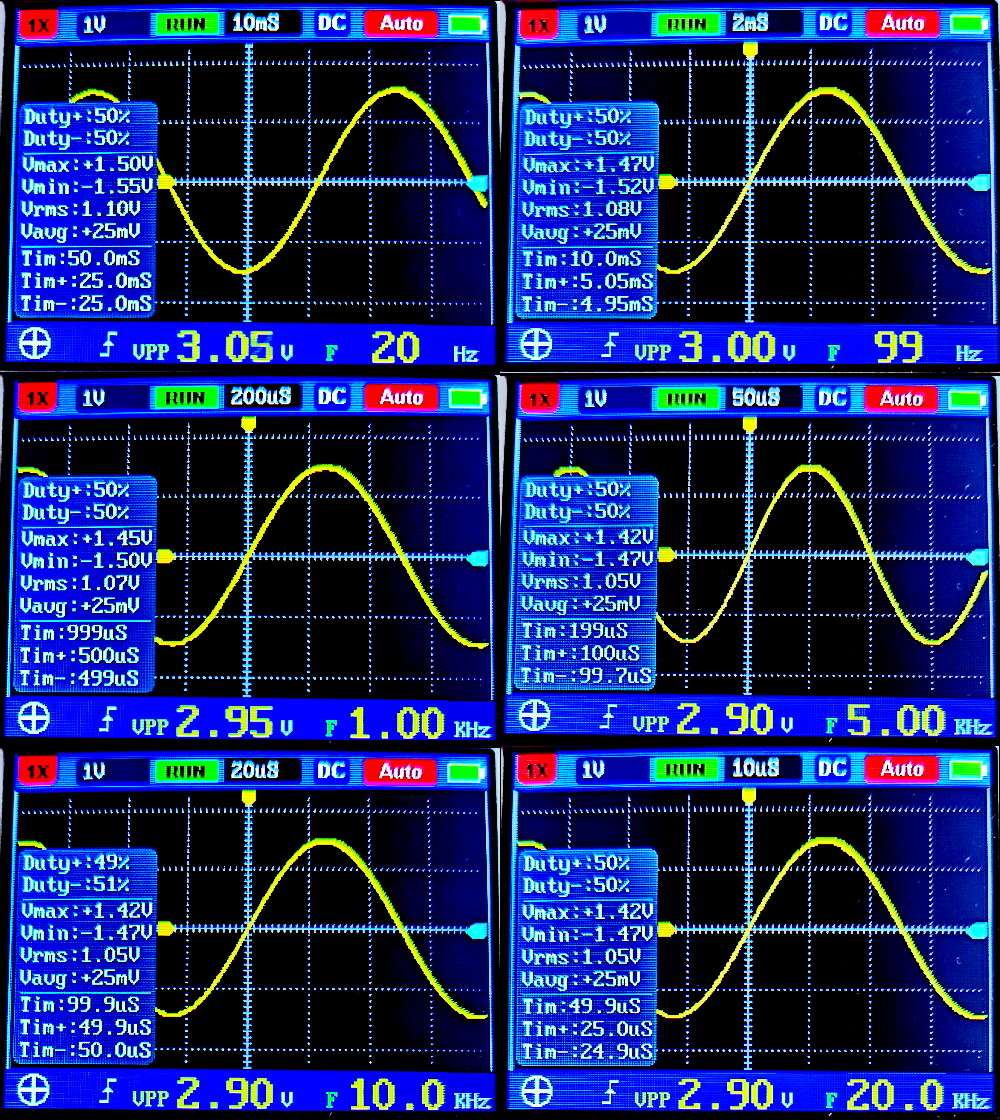
15 Ω firmware 1V
The maximum voltage obtained with this load, without visible distortion, is close to 0.6V, which means a power of 24mW.

33 Ω firmware 1V
The maximum voltage obtained with this load, without visible distortion, is just over 0.8V, which is close to 20mW power.

100 Ω firmware 1V
With this load the voltage is the maximum, as you can see, just over 1V. The power is 11mW

No load firmware 2V
It can be seen that the output voltage is clean and slightly above 2V RMS.

15 Ω firmware 2V
The maximum voltage obtained with this load, without visible distortion, is 0.911V, giving a power of 55mW.
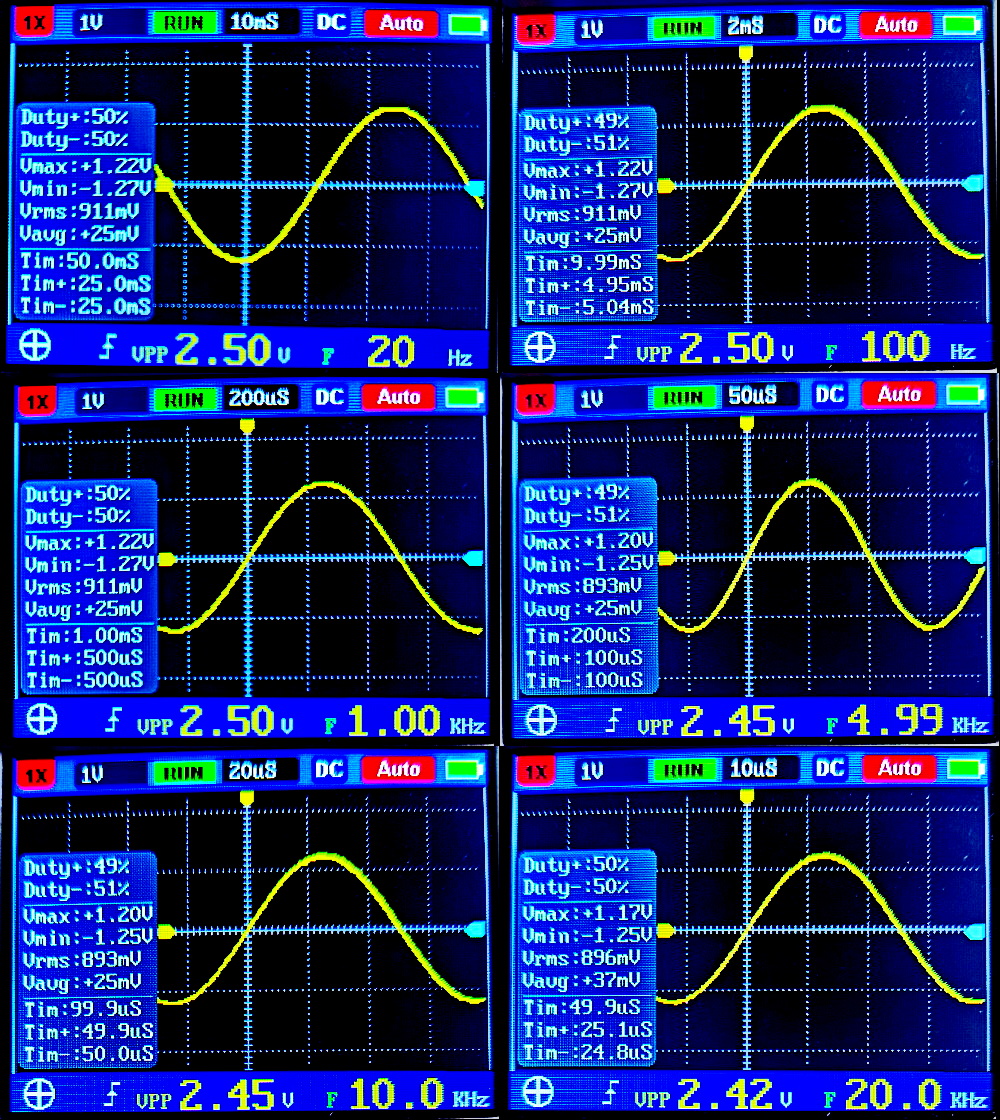
33 Ω firmware 2V
The maximum voltage obtained with this load, without visible distortion, is more than 1.5V, which means a power of 70mW. This is the specified value.

100 Ω firmware 2V
To my surprise, this load does not reach 2V cleanly. 1.9V provides 36mW.

Frequency Response
The frequency response is ultra-linear from 20Hz to 40kHz, with no crosstalk.

Sound
The sound of the Tempotec Sonata MHD is based on a completely flat and homogeneous frequency response, so the sound is balanced, but with a little hint of warmth. The result is a very pleasant sound, where everything is coherent in terms of musical quality, profile, scene, level of detail and price.
As I mentioned, there are two firmwares that allow the MHD to have one gain or the other. As standard, it came with the firmware limited to 1V. With this one, I find that for sensitive IEMS and/or low impedance, it will be very suitable, hardly anything more powerful will be necessary. But with the high gain firmware (2V), I find some more subjective boost, which allows to expand the sound on those IEMS that are a bit hungrier. It is true that the volume control will not be as precise for 2V as it is for 1V, but that is the price to pay for those who need more output voltage.
Leaving aside power considerations and returning to the pure description of the MHD's sound, like the good SABRE in it, I could describe its sound as technical, yet very coherent and mature. It is tonally effective, reliable, clear, clean and with a remarkable level of transparency. Only that small point of warmth could alter the above. This warmth appears in the transition between the lower and mid-range. At the point where the bass tends to expand, after its subsequent decay, there is a dissipation that transfers a slight haze to the sound. This is something I find unusual in analytical DACs like the ESS ones, but I perceive it as such. This particular (and personal) perception gives the sound a nuance, which detracts a bit from its transparency, separation and three-dimensionality. Although it is true that this is my own perception, it is the basis that has helped me to differentiate its sound from other devices with the same chip.
The low end is thus complete and flat, with good attack (despite the above comments), precision and resolving power. Only that hint of haze detracts from its detail and descriptive level, although, on the other hand, it adds a little more cohesion and prevents the bass from being too dry, and even manages to subtly liquefy it.
The balance and tonal respect persists in the mid-range, which is represented with clarity, a good sense of openness and transparency, despite the slight warmth. The level of resolution is remarkable and the detail very adequate, without one thinking that this is an eminently analytical device. In fact, the musical feel has a tendency towards naturalness, but Sabre can always provide a point of higher resolution and analysis. This is not a negative issue, but rather, in my opinion, an additional attraction. This character brings light and definition, counteracting the slight warmth of the lower zone. Thus, the middle zone is resolved with a good dose of transparency, an adequate amount of openness, a clean timbre, with a neutral tendency, and a balanced, pure and pleasant pattern.
In the upper range, there is no change in predisposition and everything said for the middle range could be repeated in this range. Although it is worth noting that the sound does not become more analytical in this zone, nor does it excite beyond the general neutrality of the device. The idea of purity, cleanliness, without going beyond the margin of naturalness and balance, persists. Sharpness continues to rise and the level of resolution manages to outline the top notes with good character and personality. Needless to say, there's no room for any jolts or out-of-tune peaks. And although the sound is in a price/performance range where it belongs, it is at the upper end of that range. This is not to say that we are asking for a lot, but we will not be disappointed with the highs presented by the MHD, nor with its other technical characteristics.
This new Sonata is able to provide a remarkable sense of openness, good depth and more than acceptable headroom. The level of three-dimensionality is more than average. The cleanness of the sound and its level of transparency bring to this section advantages that help it express a sense of separation, clarity and darkness between notes that are more than adequate, raising the bar above that average. Although, in any case, I wouldn't put this device in the same range as its E44 sibling in these technical aspects. It is a more mundane grade, eminently good, remarkable, but not exceptional.

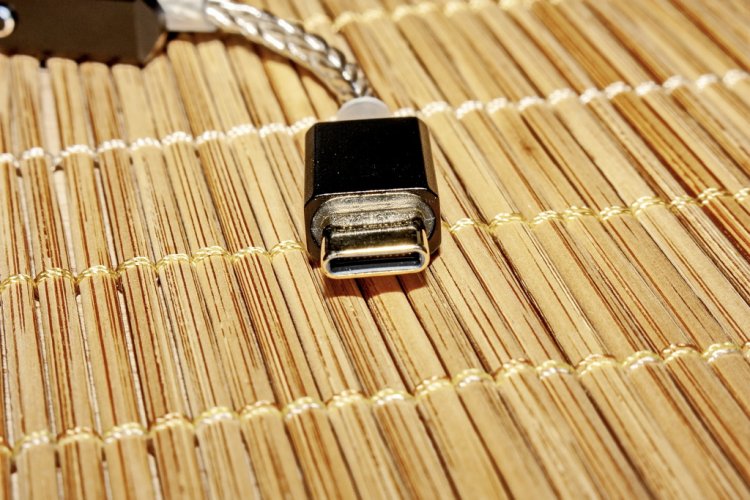
Comparisons
Hidizs S3 Pro
Both devices are very similar internally, because they have the same DAC. Externally, however, they are very different. The S3 Pro is smaller, round, with a single cable and the 3.5mm jack integrated into the aluminium body. The MHD has two cables, is a rectangular, elongated and flat tablet, with two side buttons for volume control. Basically, these buttons can be the big difference between one and the other, apart from the price. Otherwise, in sound, they are extremely similar. After many test songs, I wouldn't put my hand on the fire as to which is which. Although, I think the MHD is slightly warmer than the S3 Pro. And while both share that spark of warmth, I find a hint of greater transparency in the Hidizs. This is not that it's eminently better or worse, but it's what I said in the sound section: the low end haze is slightly higher on the MHD. On the other hand, at present, the price/performance ratio is better on the Hidizs, not to mention the fact that it has no volume control. Those who want an integrated volume control via hardware will have no problem choosing the MHD. Those who don't need it, the S3 Pro would be better value for money. However, if no one is going to use the MQA feature, I would go for its cousin E35 or, above all, the E44.
Another advantage of the MHD over the S3 Pro is the ability to use firmware to provide a maximum output of 1V or 2V. The Hidizs is more powerful at 15Ω (66mW versus 55mW), but less so at 33Ω (59mW versus 70mW).
Finally, the S3 Pro has 3 types of firmware that allow the sound profile to be changed, whereas this is not possible with the MHD.


Conclusion
The Tempotec Sonata MHD is the last component of the family, the one that was missing, the one that uses Sabre and deploys MQA 8X. To what extent this feature is relevant will be up to Tidal users to decide. For me, a non-user of streaming music, it is of little importance. But I'm sure for many others, it can make the difference between buying one dongle or another. And that is where Tempotec is not going to lose. The advantages over the other competitors are still clear, the sound is up to par and hardware volume control is not available on many of them. Hence, the combination of these two features may well tip the balance in favour of the MHD. At the other extreme, its price is quite similar to that of its E44 cousin and higher than that of the E35. In this case, the end use for which this dongle is intended will be the key to the purchase. If you use Tidal, there will be no doubt: the MHD and its volume control will be the favourite.
On the other hand, Tempotec twists and squeezes the device a little further and offers two firmwares for the MHD. As standard, the maximum voltage is 1V, aimed at use with sensitive IEMS, with the intention of improving the sensitivity of the volume control. But, as specified, the MHD can provide a maximum output of 2V, but this will require the use of firmware that releases the maximum power. Going back to 1V output will always be possible with the appropriate firmware. It is not as clean as an automatic gain detection, depending on the connected load, but it will certainly eliminate some inconsistencies that such a detection may cause. In this way, I still think that Tempotec's ability, in this kind of scenario, is on a par with few other brands.


Earphones and Sources Used During Analysis


Ratings


Purchase Link
https://es.aliexpress.com/item/1005003121525001.html

You can read the full review in Spanish here:
https://hiendportable.com/2021/11/07/tempotec-sonata-mhd-review/

Tempotec continues to squeeze its Sonata series and when it seems that there is nothing left to design, within this series, I forget that there is an acronym that I have not taken into account. It's "MQA", something that Tidal users will know very well and that this new MHD supports up to 8X, always under the HiBy Music application. Of course, it also supports DSD and DXD. Although it has very similar cables to the E44, its connection is 3.5mm SE and its body is smaller and slimmer. On the main face is the MQA logo, under which there is a multicoloured LED, indicating the status or type of file being played. On this occasion, the volume buttons are 2 and on the side. Tempotec has used the ESS Sabre ES9281 integrated DAC/AMP, so well known and used in multiple dongles. Undoubtedly, the big advantage of this new product, apart from the MQA 8X decoding, is the integrated volume control, which sets it apart from some of its competitors. We will see the rest of the features below.


Disclaimer
Tempotec, offered me this model, in exchange for writing an honest review. I want to make it clear that all my opinions written in this review have not been conditioned by this fact, nor will I ever write anything that I do not really think or feel here. I will only write about my personal opinion in relation to the revised product.

Specifications
- DAC/AMP: ESS Sabre ES9281.
- Maximum output voltage: 2V RMS.
- SNR: 128dB.
- THD + N: -112dB.
- Power: 70mW @ 32Ω.
- Support: MQA 8X.
- Support: TIDAL.
- Support: DSD128.
- Support: 32bit PCM/384kHz.
- Support: Earphone with microphone.
- Headphone output SE 3.5mm, gold plated.
- Aluminium alloy body.
- Weight: 18.5g.
- Length: 180mm

Packaging
The MHD comes in a box very similar to the E44 and E35. It is a white box with dimensions 127x100x35mm. On the front side you can see a couple of pictures of the edges of the MHD, showing each side of the device. On the back of the box is only the brand, the model, the website, the e-mail address, several QR and an EAN13. After removing the outer cardboard, a complete black box is visible again. It opens like a chest and inside you can see the MHD, the USB Type-C to classic USB adapter and a sticky Hi-Res logo, inside a thick foam moulding. Underneath, there's little else. The complete contents are:
- Tempotec Sonata MHD.
- USB Type-C female to USB male adapter.
- Gold Hi-Res AUDIO logo sticker.
- 1 protector for the back.
- 1 front side protector.
- 1 wet wipe.
- 1 dry wipe.
Everything is the same as in the previous models. And I insist on "the same," because the plastic protectors are not suitable for this new MHD, but for the previous models E35 and E44. A flaw in the accessories which, on the other hand, is not necessary on the rear face, as it is completely made of aluminium. It would make sense to have protection on the main side of the device, just to avoid scratches.
Finally, the set comes with a USB-C female to lightning male adapter as a free gift.


Construction and Design
Tempotec continues with the centre-pin design, silver-plated monocrystalline copper 8-strand cable for each end, USB Type-C connector on one side and 3.5mm SE connector on the other end. Each connector is gold-plated and identical to those on the E35. The USB male connector sleeve is the same colour as the body and is oval in shape. The headphone output connector sleeve starts out as a cylinder that turns into a rather bulky hexagon. It is also the same colour as the body. The centre pickup is smaller and narrower and still has ridges on its corners and a groove in the area where it meets the cables. It is still a black aluminium case, but, this time, the back is made entirely of aluminium. The buttons are two small ones, located on one side. The top face is glazed and has the MQA logo in its centre and the Tempotec branding at the bottom. Underneath the logo is a multicoloured LED that lights up depending on the status. The rear face has the brand logo at the top, close to the earphone output, and the model name at the bottom. The partial measurements are as follows:
- Global 182mm.
- USB connector 22.5mm.
- 3.5mm SE connector 24.5mm.
- Centre block 49.3mm.
- USB cable 45mm.
- Headphone output cable 45mm.
The weight of the pickup is light and the connectors are slightly heavier.
As you can see, there is a slight change in shape from the E-series, it is smaller and thinner, mostly covered in aluminium and with 2 side buttons for volume control. Everything else is very similar to its cousins.


Connectivity
The Sonata MHD has a USB Type-C connection, which limits it to Android, PC and DAPS compatible systems. Connected to a Windows PC it is Plug&Play, being compatible with version 10 without the need for additional drivers. It has no ASIO driver and will not be compatible with older versions of Windows.
Connected to an Android device, it is advisable to activate the "OTG" and "USB debugging mode" options. To enjoy MQA decoding it is convenient to use the HiBy Music APP.

Operativity
The E35 has 30 volume steps. But when connected to Windows, pressing each button changes the system volume by two points, giving 50 volume steps.
Apart from the advice to use the HiBy Music APP, the operation is not too difficult, apart from the fact that it seems to remember the volume position.
The Sonata MHD is able to operate in two modes, depending on the earphone connected: if it has a microphone, it automatically sets itself to call mode. If it doesn't, it auto-configures itself to HiFi mode.
The colour of the light indicates the status of the MHD, as shown below:
- Red: Connected, but paused.
- Blue: Playing PCM 32-48kHz.
- Green: Playing PCM 88.2-192kHz/DSD64.
- Clear Green: Playing PCM 352.8-384kHz/DSD128.
- Purple: Playing MQA.
Finally, it is worth noting that the MHD has a Fade-In effect, around 2 seconds, when it starts playing. There may be people who like this effect, personally, I hate it.


Measures
Tempotec certainly doesn't disappoint. If it says it delivers 70mW at 32 Ω, it does. And my first feeling was astonishment when I saw that the maximum no-load voltage barely exceeded 1 V. But how? I thought. If 2V is specified, how come it only gives 1V? My first thought was that it might have some kind of high gain mode, depending on the load connected. But it doesn't. The second thing I thought of was firmware that would provide that high gain, and so it does. I contacted Tempotec and told them about my measurements. They quickly replied and told me what I was thinking. There are two firmwares, one that provides a maximum output of 1V and one that gives 2V. The update is very simple and quick. The reason, according to the brand itself, is that with 1V they are able to offer a more precise volume control, as the jumps are not so big. Something that, on the other hand, I have come to comment on their E-series cousins.
As can be seen from the measurements at 100 Ω, the output impedance is very low, less than 1, as the voltage is the same as at no load.
Below you can see the measurements with the two firmwares.
No load firmware 1V
It can be seen that the output voltage is clean and slightly above 1V RMS.

15 Ω firmware 1V
The maximum voltage obtained with this load, without visible distortion, is close to 0.6V, which means a power of 24mW.

33 Ω firmware 1V
The maximum voltage obtained with this load, without visible distortion, is just over 0.8V, which is close to 20mW power.

100 Ω firmware 1V
With this load the voltage is the maximum, as you can see, just over 1V. The power is 11mW

No load firmware 2V
It can be seen that the output voltage is clean and slightly above 2V RMS.

15 Ω firmware 2V
The maximum voltage obtained with this load, without visible distortion, is 0.911V, giving a power of 55mW.

33 Ω firmware 2V
The maximum voltage obtained with this load, without visible distortion, is more than 1.5V, which means a power of 70mW. This is the specified value.

100 Ω firmware 2V
To my surprise, this load does not reach 2V cleanly. 1.9V provides 36mW.

Frequency Response
The frequency response is ultra-linear from 20Hz to 40kHz, with no crosstalk.

Sound
The sound of the Tempotec Sonata MHD is based on a completely flat and homogeneous frequency response, so the sound is balanced, but with a little hint of warmth. The result is a very pleasant sound, where everything is coherent in terms of musical quality, profile, scene, level of detail and price.
As I mentioned, there are two firmwares that allow the MHD to have one gain or the other. As standard, it came with the firmware limited to 1V. With this one, I find that for sensitive IEMS and/or low impedance, it will be very suitable, hardly anything more powerful will be necessary. But with the high gain firmware (2V), I find some more subjective boost, which allows to expand the sound on those IEMS that are a bit hungrier. It is true that the volume control will not be as precise for 2V as it is for 1V, but that is the price to pay for those who need more output voltage.
Leaving aside power considerations and returning to the pure description of the MHD's sound, like the good SABRE in it, I could describe its sound as technical, yet very coherent and mature. It is tonally effective, reliable, clear, clean and with a remarkable level of transparency. Only that small point of warmth could alter the above. This warmth appears in the transition between the lower and mid-range. At the point where the bass tends to expand, after its subsequent decay, there is a dissipation that transfers a slight haze to the sound. This is something I find unusual in analytical DACs like the ESS ones, but I perceive it as such. This particular (and personal) perception gives the sound a nuance, which detracts a bit from its transparency, separation and three-dimensionality. Although it is true that this is my own perception, it is the basis that has helped me to differentiate its sound from other devices with the same chip.
The low end is thus complete and flat, with good attack (despite the above comments), precision and resolving power. Only that hint of haze detracts from its detail and descriptive level, although, on the other hand, it adds a little more cohesion and prevents the bass from being too dry, and even manages to subtly liquefy it.
The balance and tonal respect persists in the mid-range, which is represented with clarity, a good sense of openness and transparency, despite the slight warmth. The level of resolution is remarkable and the detail very adequate, without one thinking that this is an eminently analytical device. In fact, the musical feel has a tendency towards naturalness, but Sabre can always provide a point of higher resolution and analysis. This is not a negative issue, but rather, in my opinion, an additional attraction. This character brings light and definition, counteracting the slight warmth of the lower zone. Thus, the middle zone is resolved with a good dose of transparency, an adequate amount of openness, a clean timbre, with a neutral tendency, and a balanced, pure and pleasant pattern.
In the upper range, there is no change in predisposition and everything said for the middle range could be repeated in this range. Although it is worth noting that the sound does not become more analytical in this zone, nor does it excite beyond the general neutrality of the device. The idea of purity, cleanliness, without going beyond the margin of naturalness and balance, persists. Sharpness continues to rise and the level of resolution manages to outline the top notes with good character and personality. Needless to say, there's no room for any jolts or out-of-tune peaks. And although the sound is in a price/performance range where it belongs, it is at the upper end of that range. This is not to say that we are asking for a lot, but we will not be disappointed with the highs presented by the MHD, nor with its other technical characteristics.
This new Sonata is able to provide a remarkable sense of openness, good depth and more than acceptable headroom. The level of three-dimensionality is more than average. The cleanness of the sound and its level of transparency bring to this section advantages that help it express a sense of separation, clarity and darkness between notes that are more than adequate, raising the bar above that average. Although, in any case, I wouldn't put this device in the same range as its E44 sibling in these technical aspects. It is a more mundane grade, eminently good, remarkable, but not exceptional.


Comparisons
Hidizs S3 Pro
Both devices are very similar internally, because they have the same DAC. Externally, however, they are very different. The S3 Pro is smaller, round, with a single cable and the 3.5mm jack integrated into the aluminium body. The MHD has two cables, is a rectangular, elongated and flat tablet, with two side buttons for volume control. Basically, these buttons can be the big difference between one and the other, apart from the price. Otherwise, in sound, they are extremely similar. After many test songs, I wouldn't put my hand on the fire as to which is which. Although, I think the MHD is slightly warmer than the S3 Pro. And while both share that spark of warmth, I find a hint of greater transparency in the Hidizs. This is not that it's eminently better or worse, but it's what I said in the sound section: the low end haze is slightly higher on the MHD. On the other hand, at present, the price/performance ratio is better on the Hidizs, not to mention the fact that it has no volume control. Those who want an integrated volume control via hardware will have no problem choosing the MHD. Those who don't need it, the S3 Pro would be better value for money. However, if no one is going to use the MQA feature, I would go for its cousin E35 or, above all, the E44.
Another advantage of the MHD over the S3 Pro is the ability to use firmware to provide a maximum output of 1V or 2V. The Hidizs is more powerful at 15Ω (66mW versus 55mW), but less so at 33Ω (59mW versus 70mW).
Finally, the S3 Pro has 3 types of firmware that allow the sound profile to be changed, whereas this is not possible with the MHD.


Conclusion
The Tempotec Sonata MHD is the last component of the family, the one that was missing, the one that uses Sabre and deploys MQA 8X. To what extent this feature is relevant will be up to Tidal users to decide. For me, a non-user of streaming music, it is of little importance. But I'm sure for many others, it can make the difference between buying one dongle or another. And that is where Tempotec is not going to lose. The advantages over the other competitors are still clear, the sound is up to par and hardware volume control is not available on many of them. Hence, the combination of these two features may well tip the balance in favour of the MHD. At the other extreme, its price is quite similar to that of its E44 cousin and higher than that of the E35. In this case, the end use for which this dongle is intended will be the key to the purchase. If you use Tidal, there will be no doubt: the MHD and its volume control will be the favourite.
On the other hand, Tempotec twists and squeezes the device a little further and offers two firmwares for the MHD. As standard, the maximum voltage is 1V, aimed at use with sensitive IEMS, with the intention of improving the sensitivity of the volume control. But, as specified, the MHD can provide a maximum output of 2V, but this will require the use of firmware that releases the maximum power. Going back to 1V output will always be possible with the appropriate firmware. It is not as clean as an automatic gain detection, depending on the connected load, but it will certainly eliminate some inconsistencies that such a detection may cause. In this way, I still think that Tempotec's ability, in this kind of scenario, is on a par with few other brands.


Earphones and Sources Used During Analysis
- Tempotec V1-A
- Xiaomi Redmi Note 8 Pro
- BGVP ArtMagic VG4
- ISN H40
- NS Audio NS5 MKII Extra Bass
- LZ A4 Pro
- Dunu Falcon Pro
- NiceHCK TopGuy
- NiceHCK Lofty
- Yanyin Aladdin
- NF Audio NA2+
- Ikko OH10
- NiceHCK EBX21
- Smabat M0
- Hessian Ansata Pro


Ratings
- Construction and Design: 87
- Packaging and Accessories: 75
- Connectivity: 80
- Operability: 78
- Sound: 85
- Quality/Price: 80


Purchase Link
https://es.aliexpress.com/item/1005003121525001.html

You can read the full review in Spanish here:
https://hiendportable.com/2021/11/07/tempotec-sonata-mhd-review/

Last edited:
toge
are there any instructions on updating the MHD?
cqtek
You can download the 1V or 2V firmware from this link. Connect the dongle to the PC. Then, run the "FWBurner_cust new" application, choose the target shown in the image, select the appropriate firmware file and press Burn.
https://www.tempotec.net/pages/firmware-download
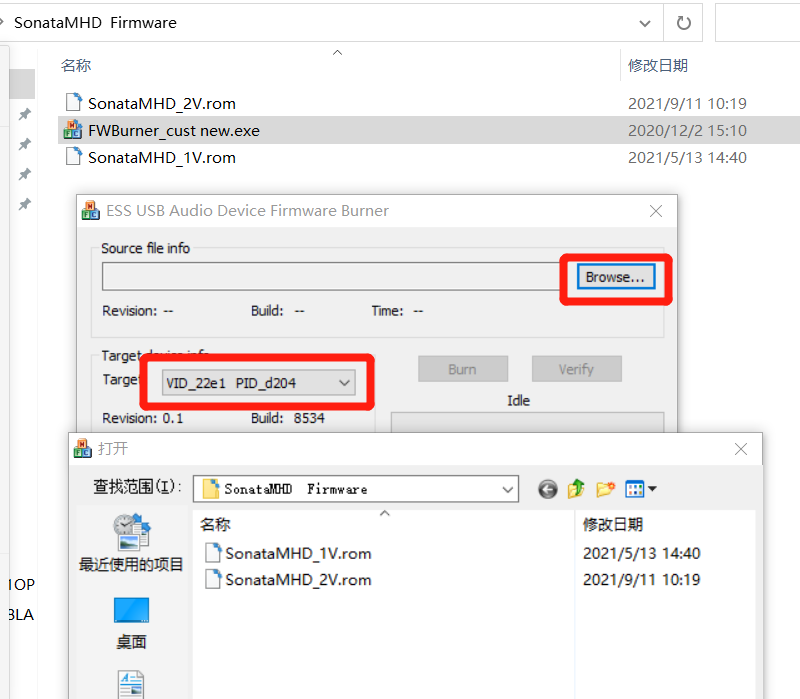
https://www.tempotec.net/pages/firmware-download



Bro, do you still have the 2Vrms firmware files?
I realized that mine too is outputing only 0,97Vrms.
Thanks!